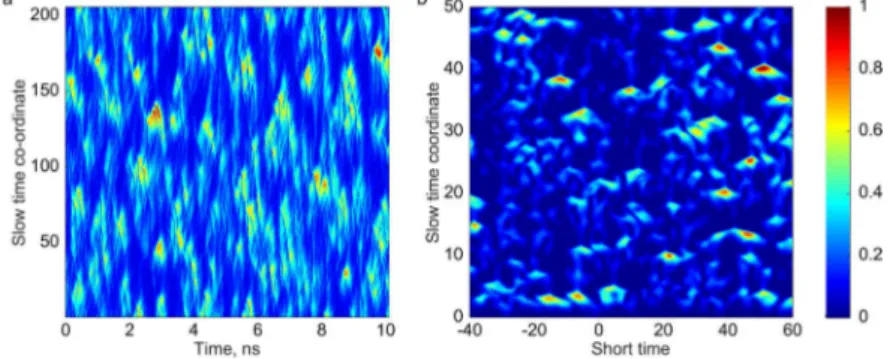Optical Turbulence and Polarization Rogue Waves in Experiments and
Ginzburg-Landau Model of Quasi-CW Fiber Laser
S. Sugavanam1, N. Tarasov1,2, S. Wabnitz3, D. Churkin1,4,5
1. Aston Institute of Photonic Technologies, Aston University, Birmingham, B4 7ET, UK 2. Institute of Computational Technologies SB RAS, Novosibirsk, 630090, Russia
3. Dipartimento di Ingegneria dell'Informazione, Universita di Brescia, and Istituto Nazionale d'Ottica del CNR, Brescia 25123, Italy 4. Institute of Automation and Electrometry, Siberian Branch of the Russian Academy of Sciences, Novosibirsk, 630090, Russia
5. Novosibirsk State University, Novosibirsk, 630090 Russia
Fiber lasers operating via Raman gain or based on rare-earth doped active fibers are widely used as sources of CW radiation. However these lasers are only quasi-CW: their intensity fluctuates strongly on short time-scales and they are usually described within the NLSE model [1]. On the contrary, mode-locked pulsed lasers could be well modelled in terms of the complex Ginzburg-Landau equation (GLE). By replacing cubic nonlinear gain with a nonlinear loss term, one may obtain a variety of mode-locked regimes, including those of very irregular time dynamics which could be referred to as turbulent emission [2]. Here we show that CW Raman fiber lasers could be surprisingly described within the framework of the complex Ginzburg-Landau equation.
In our experiments, we use a linear cavity Raman fiber laser, nominally operating in the CW regime. We experimentally characterize its radiation by a technique of spatio-temporal intensity dynamics measurements [3] and found intermittent turbulent like behaviour, Fig. 1a.
Fig. 1 Spatio-temporal turbulent dynamics of quasi-CW Raman fiber laser in (a) experiment and (b) modelling.
In spite of the fact that the laser operates in the quasi-CW regime, we use the Ginzburg-Landau equation model to describe its light emission. We found a good qualitative agreement with between the experimentally measured spatio-temporal dynamics of the quasi-CW fiber laser and the numerically calculated dynamics within the developed vector phenomenological model based on the coupled GLEs, Fig. 1. This clearly shows that the
quasi-CW fiber laser can be effectively described by a phenomenological model that is widely used for the
modelling of mode-locked lasers.
Fig. 2 Polarization rogue waves in CW Raman fiber laser in (a) experiments and (b) modelling.
Further on, the developed vector model of quasi-CW lasers provides the possibility to analyze the intensity dynamics in two orthogonally polarized modes. We found both in experiments and in modelling that most of extreme events occur in a single polarization, Fig.2 (red and blue – intensities in orthogonal polarizations).
To conclude, the framework of the complex Ginzburg-Landau equations, that are well known as an efficient model of mode-locked fiber lasers, is applied for the description of quasi-CW fiber lasers. The first ever vector model of a Raman fiber laser describes the experimentally observed turbulent-like intensity dynamics, as well as polarization rogue waves. Our results open debates about the common underlying physics of operation of very different laser types - quasi-CW lasers and passively mode-locked lasers.
References
[1] D.V. Churkin, S.V. Smirnov, “Numerical modelling of spectral, temporal and statistical properties of Raman fiber lasers,” Opt. Commm 285, 2154 (2012).
[2] S. Wabnitz, “Optical turbulence in fiber lasers”, Opt. Lett. 39, 1362 (2014).
[3] E.G. Turitsyna, S. V. Smirnov, S. Sugavanam, N. Tarasov, X. Shu, S. A. Babin, E. V. Podivilov, D. V. Churkin, G. Falkovich, and S. K. Turitsyn, “The laminar-turbulent transition in a fibre laser,” Nature Photonics 7, 783 (2013).
